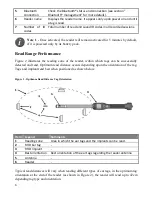
9
Wireless synchronization
A reader which is in the vicinity of a second reader is very likely to transmit its activation
signal during the listening pause of the second reader and vice versa. The result is that
neither reader will be able to receive the HDX telegram.
Wireless synchronization can be used to control the coordination of readers. The proviso is
that the electrical noise in the environment is low and the RFI noise is constant, for the type
of readers in use.
Item Legend
Comments
1
Activation signal
of reader 1
-
2
Reader 1
reader 1 in transmitting mode.
3
Activation signal
from reader 1
-
4
Reader 2
reader 2 in listening mode.
“A mobile transceiver by nature cannot directly be connected to other transceivers. To
prevent a mobile transceiver interfering with the interrogation protocol of other
transceivers, it must be able to detect the presence of additional active transceivers through
the reception of activation signals.
If no activation signal is detected within 30 ms, the transceiver is out of reach of other active
transceivers and its activation signal will not interfere with other interrogation processes.
The transceiver can therefore safety use the protocols defined in clause 6 of this
International Standard. If the mobile transceiver detects an activation signal it must wait for
the rising edge of the next activation signal and activate during a fixed period of 50ms.” (cf.
ISO1185 – Annex C chapter 3)
Note 3
– Activate the wireless synchronization feature only with readers which
comply with the ISO11785 timings.










































